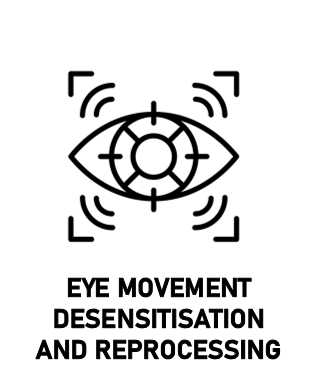Eye Movement Desensitisation and Reprocessing (EMDR) is the name of a therapy that is being increasingly used in mental health.
While more of a newer treatment, EMDR is an exciting intervention that has helped many people cope with trauma-based conditions.
This therapy involves an individual moving their eyes from side-to-side, with the therapist directing their eye movements. During this, the individual recalls their traumatic experience.
EMDR is believed to help an individual change how they think about the traumatic event, with the therapist aiming to facilitate change.

The Science Behind Eye Movement Desensitisation and Reprocessing
It isn’t entirely clear how EMDR works. EMDR was developed by American psychologist Doctor Francine Shapiro.
She developed EMDR as a result of her own personal experience, using areas that worked for her. She found that certain eye movements helped to reduce the severity of negative thoughts or disturbed thinking.
Shapiro organised a large study, which seemingly showed its effectiveness. She stated that when a person had a traumatic experience, that their normal coping mechanisms would be overpowered.
As a result, the memory would not be processed correctly, leading to the memory being stored in a different area to non-traumatic areas, and never dealt with.
Shapiro posited that eye movements changed when faced with certain thoughts. Therefore, eye movements can lead to a change in how memories are processed, seemingly helping a person come to terms with their trauma.
The suggestion is that EMDR can help a mind heal quickly, much like a physical wound does.
How Does Eye Movement Desensitisation and Reprocessing Work?
EMDR attempts to lessen the severity of a person’s difficulties, which are usually related to a past traumatic experience.
A patient will work with a therapist during sessions. The session involves a patient making side-to-side eye movements – following the movement of a therapist’s hand motions, where they’ll typically move their fingers back and forth and side to side.
This induces a state where a person is in an advanced state of REM (rapid eye movement – something that happens during sleep), and therefore may help them process memories better.
During the eye movements, the person will recall their traumatic experience, and over time, the therapist will guide their thoughts to more positive ones.
The patient is not sedated in any way, and what happens is a natural process. EMDR therapy is split into eight phases, for more information, we have a separate article [construction].
A patient will typically need to attend 3-12 sessions, each of which is normally 90 minutes long. Dr. Shapiro stated that three 90-minute sessions would suffice.
However, it seems the time needed depends on the nature of the trauma. Prior to starting therapy, the therapist will ensure the person is in a mental state conducive to undertaking EMDR.
After each session of EMDR, the patient will be asked how they are feeling – with their progress tracked throughout the therapy.
Following EMDR, it is hopeful that a person will no longer be bothered by their past trauma, or at least not to the same extent as before. A person may relapse in the future, though EMDR has a good effectiveness rate.
When is Eye Movement Desensitisation and Reprocessing Useful?
EMDR has been proven to be useful in trauma-based conditions, such as Post-traumatic stress disorder, complex post-traumatic stress disorder, adjustment disorders, or any case where a person has unresolved traumas that are causing them problems in their life.
Therefore, it can be helpful for any mental health condition. However, for patients who don’t have past traumas to work through, a different therapy would probably be more effective.
EMDR is useful as it deals with the past and the present. Past traumas are discussed, so it can be difficult, but hopefully EMDR enables a person to move on from the past, which in turn will improve their present-day life.
While EMDR does help many people, it isn’t for everyone. Each patient’s circumstances are different.
How effective is Eye Movement Desensitisation and Reprocessing?
EMDR is a controversial treatment, and studies into it have been both positive and negative towards its efficacy.
A study in 2006 that took into account multiple previous studies found that EMDR had about the same rate as exposure therapy – normally the therapy of choice for PTSD [1].
Another study concluded EMDR was actually more effective than exposure therapy [2]. In general, it seems EMDR is an effective treatment for anyone with trauma-related conditions, though some studies have suggested it is not effective.
EMDR seems to also be useful in treating many symptoms associated with mental health such as low self-esteem. It is never known prior to therapy whether or not someone will find EMDR to be helpful – it isn’t a one-size fits all therapy.
How to find a therapist?
It is recommended that you contact your GP and inform them of your problems. They will refer you to the relevant mental health team.
If you are aiming to use the private sector, you could ask your GP or someone you know for a recommendation. You can also look online – the British Association for Counselling and Psychotherapy have a therapist directory on their site.
See Also
- Therapy Home
- Everything You Need To Know About Talking Therapy
- FAQ’s About Talking Therapy
- Eye Movement Desensitisation and Reprocessing: Everything You Need to Know
- The Advantages and Disadvantages of Eye Movement Desensitisation and Reprocessing
- 8 Things You Should Know About Eye Movement Desensitisation and Reprocessing
- The Science Behind Eye Movement Desensitisation and Reprocessing
- The Eight Phases of Eye Movement Desensitisation and Reprocessing
Disclaimer
This website should be used purely for informational purposes, and does not intend to, nor should it ever, be used as a replacement for professional medical advice.
We strive to keep all of our pages updated, and ensure that our website is full of factual and in-depth information. However, we encourage you to browse this website with care.
As a reminder, this website and all content within it cannot and should not replace the advice of a trained medical professional. You can read our full disclaimer at this link.
Helplines
If you are struggling with your mental health, help is available. With the right support and treatment, you can make a recovery. For information on helplines, or if you are in a state of crisis, please visit our crisis page by clicking on the relevant link for your geographical location (United Kingdom), (United States), (International). You can also see how to get mental health treatment and the process involved by clicking this link.
References
[1] Seidler, G. H., & Wagner, F. E. (2006). Comparing the efficacy of EMDR and trauma-focused cognitive-behavioral therapy in the treatment of PTSD: a meta-analytic study. Psychological Medicine. 36 (11), p1515–1522.
[2] Ironson, G., Freund, B., Strauss J. & Williams, J. (2002). Comparison of two treatments for traumatic stress: a community-based study of EMDR and prolonged exposure. Journal of Clinical Psychology. 58 (1), p113-128.


































